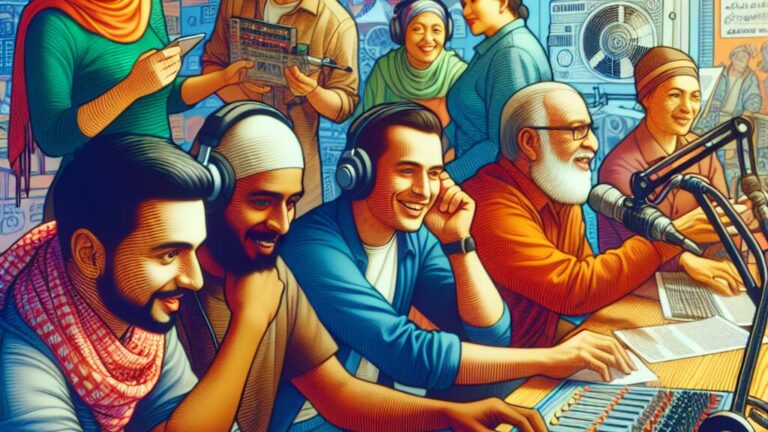The historical significance of community radio
Table Of Contents
Exploring the Historical Significance of Community Radio in Society
Key Takeaways
- The importance of community broadcasting and its development over time.
- Influence on regional populations and their engagement.
- Contribution to societal transformation and activism.
- Function during times of governmental instability and unrest.
- Innovations in technology that improve community broadcasting.
- Historical relevance of community radio within the media framework.
The Historical Significance Of Community Radio | The Evolution of Community Radio
The historical significance of community radio is rooted in its ability to serve local populations by providing a platform for diverse voices that are often underrepresented in mainstream media. Community radio stations emerged as a grassroots response to the broad landscape of national public radio and commercial broadcasting, aiming to address local issues and cultural expressions. Organizations such as the World Association of Community Radio Broadcasters and the National Campus and Community Radio Association have played pivotal roles in supporting these stations. By fostering a community radio network, these entities have helped to ensure that community radios can thrive, enriching public discourse and enhancing civic engagement. The radio authority has recognized the value of these stations, affirming their role in promoting democracy and social change through accessible broadcasting that emphasizes local narratives.
The historical significance of community radio | Early Beginnings of Community Radio
Community radio emerged as a vital platform during the early developments of broadcasting. The historical significance of community radio is deeply intertwined with grassroots efforts to make voices heard that were often overlooked by mainstream media. Radio stations began to pop up globally, including in the United States, where initiatives led to the establishment of diverse formats like campus radio and national public radio (NPR). The role of organizations such as the Community Radio Forum of India showcased a commitment to serve local populations and promote cultural expression.
In various regions, community radio became a beacon for marginalized communities. E rádio stations and BBC local radio broadcasts offered alternatives to commercial networks, emphasizing local issues and cultural narratives. In places like Bangladesh, community radio in Bangladesh cultivated a sense of belonging and facilitated discussions on social change. These early broadcasts laid the groundwork for recognizing the importance of community-driven communication, marking a significant evolution in the media landscape.
Notable Milestones in Community Radio History
The historical significance of community radio can be traced through several notable milestones that shaped its development. One major event was the formation of grassroots radio coalitions in the 1970s, which brought together marginalized voices to challenge mainstream narratives. Among these initiatives was Pacifica Radio, a pioneering network that established a platform for progressive ideas. This era also witnessed the rise of campus radio stations, which provided students with the opportunity to explore radio broadcasting beyond the confines of commercial radio.
The establishment of amateur radio and bush radio networks played a critical role in expanding local communication capabilities. These radio broadcasts often filled gaps in coverage left by traditional stations, allowing communities to articulate their unique stories. As various radio frequencies were allocated, the emergence of diverse radio broadcasters contributed to a rich tapestry of voices. This dynamic landscape laid the groundwork for the continued relevance of community radio, showcasing the historical significance of community radio in shaping media discourse.
| Year | Milestone | Significance |
|---|---|---|
| 1970 | Formation of Pacifica Radio | Provided a platform for progressive and marginalized voices in media. |
| 1970s | Grassroots Radio Coalitions | Combined efforts of local broadcasters to challenge mainstream narratives. |
| 1980 | Growth of Campus Radio | Enabled students to engage in radio broadcasting and produce independent content. |
| 1990 | Establishment of Amateur Radio Networks | Filled communication gaps and strengthened local voices in remote areas. |
Impact on Local Communities
Community radio has played a vital role in shaping local communities, reflecting the historical significance of community radio through various grassroots movements and cultural expressions. By operating through FM radio stations and internet radio platforms, such as Radio New Zealand and Radio Sagarmatha, these stations provide a channel for marginalized voices and promote inclusivity. Pirate radio stations, like Radio Alice, have also emerged as pivotal players in fostering community activism and social change. Utilizing radio waves and diverse radio frequencies, local radio studios have become essential hubs for civic engagement, allowing residents to discuss issues that matter most to them. The historical significance of community radio is evident in its ability to empower individuals and create a sense of belonging within the community.
Grassroots Movements and Cultural Expression
Community radio has played a crucial role in promoting grassroots movements and cultural expression throughout its history. The historical significance of community radio is evident in the way local radio channels have provided a platform for diverse voices, fostering a sense of identity and belonging within their communities. For instance, radio Sutatenza, one of the first community radio initiatives, highlighted the power of local community radio to address specific cultural narratives and challenges. Over the years, many community radio stations have emerged, each contributing to a rich tapestry of contemporary community radio that reflects the unique stories and experiences of their populations.
The best-known community radios have become more than mere entertainment sources; they function as vital tools for social change and activism. Several community radio stations actively support local initiatives, encouraging participation in cultural events and discussions that resonate with listeners. The historical significance of community radio in this context cannot be overstated, as it underscores how community radio exists as a vehicle for cultural expression and grassroots advocacy. New community radio projects continue to thrive, helping to amplify marginalized voices and celebrate the diversity that modern societies encompass. This legacy of connection and empowerment remains central to the mission and impact of community radio today.
Fostering Civic Engagement and Participation
Community radio serves as a powerful tool for enhancing civic engagement and participation within local communities. The historical significance of community radio is evident in how it empowers voices that might otherwise go unheard. The community radio sector enables stakeholders to share pertinent information that affects their lives through accessible platforms. American community radio stations often function as catalysts for community-driven initiatives, leveraging community radio awareness to encourage local participation in governance and civic activities. The community radio handbook often highlights various strategies for effective community radio intervention that facilitate grassroots movements and foster inclusive dialogue.
Local-level community radio initiatives provide vital services that strengthen democratic processes and civic responsibility. Community radio practitioners play a critical role in shaping community radio policy, ensuring that programs reflect the needs and interests of their listeners. By broadcasting relevant news and organizing town hall meetings, these stations create an environment where civic engagement flourishes. Moreover, the second community radio era has seen an increase in collaboration among organizations, significantly enhancing the reach and impact of community radio services across diverse demographics. This collective effort furthers the goal of cultivating informed and active community members.
The Role of Community Radio in Social Change
Community radio serves as a powerful medium for social change, highlighting its historical significance by amplifying the voices of marginalized groups. The operational community radio fosters an inclusive environment, allowing small community radio stations to reach local audiences effectively. Through community radio broadcasts, listeners access vital information and cultural expression, empowering them to engage in proactive community initiatives. These functional community radio installations adhere to specific community radio guidelines, ensuring they remain accountable and responsive to local needs. Temporary community radio projects often emerge during crises, demonstrating the medium’s adaptability and importance in times of turmoil. As a community radio forum, these platforms support grassroots movements and advocacy efforts, solidifying their role as essential tools for social transformation.
Advocacy for Marginalized Voices
Community radio has emerged as a powerful platform for advocating the voices of marginalized groups. The historical significance of community radio is evidenced by nonprofit radio stations that specifically serve underrepresented communities. Important radio stations like civil rádió and community radio naf have pioneered efforts to amplify these voices, often focusing on local issues and cultural expressions. Community-based radio broadcasting allows diverse perspectives to be shared through targeted radio programmes designed to educate and inform. This initiative empowers communities while fostering solidarity among various groups.
Community radio broadcasters play a crucial role in supporting social justice movements by engaging in advocacy and storytelling. Platforms like community radio mukti and community radio sagor exemplify how these non-profit community radio stations become essential tools for change. They serve as community-radio peers, sharing resources and strategies to enhance the impact of their voices. By reaching out to the marginalized, these broadcasters not only elevate concerns but also contribute to a richer, more inclusive media landscape, thereby reinforcing the historical significance of community radio.
Educational Initiatives and Awareness Programs
Community radio has played a crucial role in educational initiatives by serving as a platform for local knowledge and cultural expressions. Desirous community radio stations, like Community Radio Sagardwip and Community Radio Pollikontho, promote awareness through programs that address the unique needs of their communities. These educational community radios often focus on issues pertinent to their listeners, such as health, agriculture, and local governance. The historical significance of community radio is particularly evident through the empowerment it provides to first nations radio networks and non-governmental radio initiatives that foster access to information.
Such radio stations engage in public radio policymaking by demonstrating the value of inclusive content and participatory practices. Educational programs offered through Barandro Community Radio and local radio stations cultivate informed citizens who can actively participate in their communities. Radio conferences further highlight the importance of radio services in disseminating knowledge and promoting civic engagement. The historical significance of community radio lies in its ability to transform local narratives into educational opportunities, impacting social development positively.
Community Radio During Political Turbulence
During times of political turbulence, the historical significance of community radio becomes even more pronounced. Ethnic-specific radio programs and festival radio play a vital role in reflecting the diverse voices within communities, particularly when mainstream media may be unresponsive or biased. Community radio outlets such as Community Radio Jhinuk offer unique radio programs that address local issues, allowing marginalized groups to share their narratives. Experienced radio practitioners often utilize homemade radio techniques to establish a direct connection with the audience. Campus-based radio initiatives and rural radio services provide platforms for youth and rural populations to participate in political discourse, fostering civic engagement. Government radio content may not always represent local perspectives, making community radio a crucial lifeline during unrest, showcasing its ability to promote resistance and activism through broadcasts.
Resistance and Activism Through Broadcasts
Community radio has played a pivotal role in resistance and activism, particularly in contexts where mainstream media fails to represent the voices of marginalized populations. The historical significance of community radio is evident in various independent radio initiatives, such as Community Radio Mahananda and Community Radio Meghna in Bangladesh. These stations have become beacons of hope, providing essential public radio programming that addresses local issues. Unlike commercial radio stations, community radios create a platform for grassroots movements, enabling residents to share their stories, advocate for their needs, and engage in meaningful dialogue.
Independent radio movements like Aboriginal Public Radio and East London Radio exemplify how community radio serves as a tool for social change and activism. By broadcasting content that reflects the realities of their communities, these stations address topics often overlooked by larger media outlets. Community Radio Padma and Union Radio Stations are instrumental in fostering civic engagement, using their broadcasts to mobilize citizens around pressing social and political issues. The historical significance of community radio continues to emerge as these platforms adapt and respond to the needs of their audiences, reinforcing the essential connection between local voices and transformative action.
Case Studies of Community Radio in Conflict Zones
Community radio has played a pivotal role in conflict zones, serving as a vital source of information and a platform for marginalized voices. The historical significance of community radio is particularly evident in instances where live terrestrial-broadcast radio provided communities with timely updates during crises. Stations like community radio Nalta and Safa Radio have emerged as lifelines, enabling residents to share news and express their concerns freely. These community stations not only promote local culture but also foster a sense of unity among listeners. The resilience of community radio, including initiatives such as trade-union radio and community radio Chilmari, highlights its importance in maintaining social cohesion amid turmoil.
The emergence of subversive radio networks has marked a significant shift in the landscape of media in conflict areas. Independent radio competition, exemplified by the radio broadcasting spread in regions like the Sundarbans, showcases how grassroots efforts can challenge dominant narratives. Community radio Sundarban has proven essential in raising awareness about local issues, while also encouraging civic participation. These community stations mobilize listeners around shared experiences and foster advocacy efforts, ultimately contributing to a more informed and engaged populace in the face of adversity. The historical significance of community radio remains evident as it continues to inspire resistance and promote dialogue in some of the most challenging environments.
- Community radio acts as a reliable source of information during crises, keeping locals informed.
- Stations provide a platform for marginalized voices, ensuring diverse opinions are heard.
- They promote local culture, helping to preserve traditions and customs amidst conflict.
- Community radio fosters unity and social cohesion by bringing people together around shared issues.
- These stations encourage civic engagement and advocacy, empowering citizens to voice their concerns.
- Independent radio networks challenge mainstream media narratives, offering alternative viewpoints.
- The resilience of community radio highlights its potential to inspire social change in conflict-affected areas.
The Technological Advancements Enhancing Community Radio
The historical significance of community radio is vividly illustrated through its evolution driven by technological advancements. From the early days of radio unitra to the establishment of India radio stations, community broadcasting has transformed significantly. Innovations have enabled stations like kbsu radio and the rise of percent radio to reach wider audiences while adhering to campus-radio guidelines. Radio amateurs have played a critical role in this transition, experimenting with broadcasting techniques and contributing to the vibrant landscape of community radio. The emergence of the pirate radio movement challenged existing paradigms, showcasing the power of grassroots communication. Notable examples include radio amy and radio animas, which demonstrate how first community stations not only serve local needs but also foster cultural expression and civic engagement.
- The rise of digital broadcasting allowing for clearer sound quality and broader reach.
- The use of social media platforms for promotion and audience engagement.
- Implementation of mobile apps that enable listeners to tune in from anywhere.
- Development of podcasting features to extend content accessibility.
- Integration of community feedback mechanisms to enhance programming relevance.
- Utilization of online streaming to reach international audiences.
- Adoption of low-power FM technology that supports smaller, local stations.
Transition from Analog to Digital Broadcasting
The shift from analog to digital broadcasting marked a transformative phase in the historical significance of community radio. Gulf-based radio stations and emerging platforms such as Radio Vanguardia began to adopt digital technologies, expanding their reach and capabilities. This evolution enabled community broadcasters, including initiatives like Radio Pío and Radio Bantu, to deliver content more efficiently and interactively. Early community broadcasters embraced these advancements, ensuring that local voices remained integral to the media landscape. The rise of campus radio studios and community media news platforms further illustrated the growing importance of digital tools in fostering local narratives.
This transition also highlighted significant changes in the public’s engagement with community radio. Digital broadcasting facilitated the emergence of dynamic programs, such as Fiksz Rádió and Community Radio Sarabela, which encouraged participation and dialogue among listeners. The integration of radio-television formats created opportunities for cross-platform storytelling, enhancing the overall impact of community initiatives. As technology evolved, the history of community radio showcased how these advancements could empower local populations, solidifying the historical significance of community radio as a crucial medium for activism and cultural expression.
The Role of Internet and Social Media
The rise of the internet and social media has transformed the landscape of community broadcasting. The historical significance of community radio is evident as radios communautaires adapt to digital platforms, allowing community-based broadcasting to expand its reach. Notable stations that once relied solely on traditional airwaves now utilize online streaming and social media to share local news and connect with audiences worldwide. This evolution signifies a shift in the community broadcasting strategy, where small community stations can effectively engage with their listeners and provide a platform for diverse voices.
The incorporation of social media has empowered community access broadcasters to foster deeper interactions with their audience. By creating a community media center online, these broadcasters encourage participation in discussions, events, and local issues. Canadian radio-television regulations support this growth, allowing for innovative approaches to content delivery and audience engagement. Through these channels, community radio not only addresses historical controversies but also enhances its role in promoting civic dialogue and cultural expression within local communities.
Historical Significance of Community Radio in Media Landscape
Community radio has played an essential role in shaping the media landscape, especially within specific geographic communities. The historical significance of community radio lies in its ability to serve as a platform for grassroots expression, fostering a sense of belonging among local populations. Stations like Sangam Radio and Radio Latacunga have become vital community media centers, offering community-news programs that address the unique needs and concerns of their audiences. The growth of community networks, such as Fúzió Rádió and las radios, showcases how these platforms empower members of their particular communities to engage in meaningful dialogue and activism. Initiatives like community radio Lokobetar exemplify the impact of localized broadcasting in promoting cultural narratives and enhancing civic participation. Overall, the historical significance of community radio is underscored by its commitment to amplifying marginalized voices and creating a thriving space for community media.
| Community Radio Station | Location | Year Established | Key Focus Area |
|---|---|---|---|
| Sangam Radio | India | 2006 | Cultural Heritage & Local News |
| Radio Latacunga | Ecuador | 1998 | Local Community Issues |
| Fúzió Rádió | Hungary | 2011 | Youth Empowerment |
| Lokobetar | Nepal | 2008 | Civic Participation |
| Las Radios | Latin America | 2000 | Grassroots Movements |
Conclusion
The historical significance of community radio is evident in its evolution from early grassroots initiatives to vital platforms for music stations and diverse voices. Al-Balad Radio and Radio Sucre exemplify how local broadcasters serve community interests, providing a space for cultural expression and dialogue. The historical examination of these radio stations highlights how they have empowered marginalized communities, with figures like the first radio producer/presenter paving the way for future radio endeavors. Sangham Radio and other radiodiffuseurs communautaires continue this legacy, fostering connection and advocacy in the media landscape. Through their programming, these stations reflect the rich tapestry of local narratives and contribute to the overall historical significance of community radio.
FAQS
What role do community-based radio stations play in the support of unique radio programmes for particular communities in the United States?
Community-based radio stations serve as vital platforms for community radio support, allowing local stakeholders to create unique radio programmes that reflect the needs and interests of their geographic community. These stations often feature community radio broadcasters who provide content tailored to ethnic-specific radio programmes as well as home-made radio segments, ensuring that the voice of the community is amplified on the radio dial. The proactive approach of these community radio licenses fosters an inclusive environment where a variety of perspectives can be shared, contributing to the diversity and richness of radio in the United States.
How can community radio stakeholders effectively utilize the community radio medium to serve the particular community they represent?
Community radio stakeholders can effectively utilize the community radio medium by actively engaging with the local population to understand their needs and preferences. This proactive community radio approach allows community-radio broadcasters to create content that resonates with the audience. They can also collaborate with other community media centers to share resources and ideas. In places like Bangladesh community radio, having a community radio licence enables them to establish their own radio stations, which can become a crucial platform for addressing the voices and issues pertinent to their particular community.
How do rádios impact local culture and identity through community radio peer networks?
Rádios serve as vital platforms for local expression, allowing communities to share their narratives and preserve cultural identity. Through community radio peer networks, these stations can access a broader range of resources and support, enhancing their reach and efficacy. Furthermore, the integration of radio frequency technology, along with initiatives like the first cable radio systems, has allowed community media centres to disseminate content more widely, fostering greater engagement within the community.
What is the importance of community radio in enhancing local culture and identity within specific communities?
Community radio is vital in enhancing local culture and identity as it provides a platform for diverse voices, encourages local participation, and promotes cultural heritage through programming tailored to the interests and issues of specific communities.
How have community radio stations historically contributed to the dissemination of local news and cultural identity within specific communities?
Community radio stations have historically played a crucial role in disseminating local news and strengthening cultural identity by providing a platform for local voices, promoting community events, and sharing culturally relevant content that reflects the unique character of specific communities. This fosters a sense of belonging and empowers community members to engage with their local culture actively.







